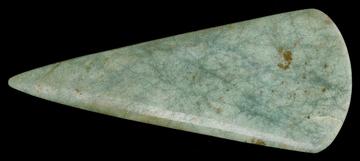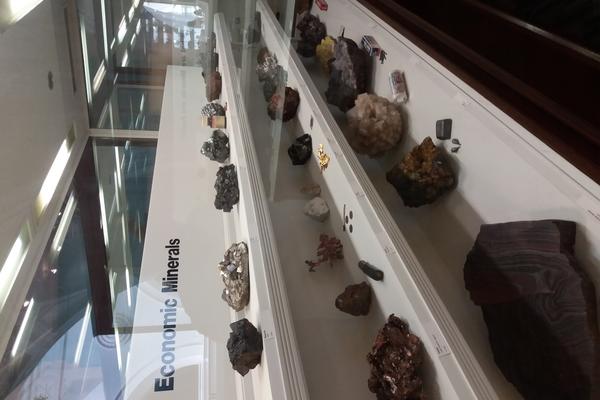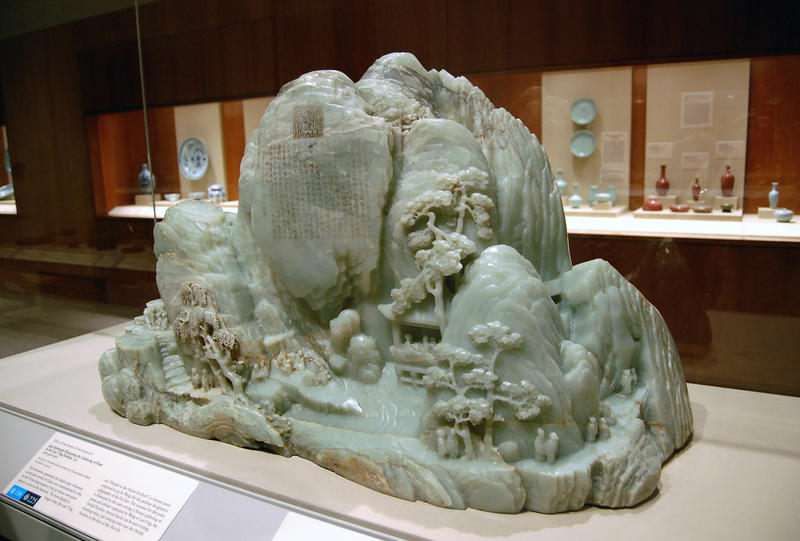More than Monetary: How We Value Minerals
Minerals are the building blocks of rocks and fossils, and are the raw products for a variety of objects common to our daily life, including batteries and electronics. Humans have been using minerals since prehistory to create pigments, pottery, metals, jewellery, and other objects.
Because of the effort necessary to find, extract, and process minerals, mineral products, including pigments, were highly valuable. Many cultures, such as the Ancient Egyptians and the Late Stone Age peoples of Europe, would reserve minerals for objects that they wanted to last for multiple lifetimes. These status symbols were clear displays of wealth, advancement, culture, and power.

Jadeite axes were one of the status symbols common across western Europe in the Late Stone Age. While the jadeite was mined in the Alps, this axe (and many others like it) was found in Scotland.
© National Museums Scotland - Object # X.2011.3

A display at Field Museum (Chicago, IL, USA) showing various minerals and their resultant products. These include currency, medication, nails, and toothpaste.
K. Royce 2018 - CC BY-SA 4.0
We place similar value on mineral products today. The price for gemstones and precious metals demonstrates that minerals are still considered economically valuable. But beyond their monetary and aesthetic value, minerals are treasured for their historical and cultural significance as well as their informational and educational potential.
Historical and Cultural Value
Minerals, just like any object, can be a link between a material and its people. Specimens can be associated with a particular person or culture (like jades are to Chinese culture). Specimens may even have an interesting story and history.
Sharing these stories and associations with museums-goers helps to put the object into context. This is tremendously valuable and powerful. Especially when the object or specimen is displayed next to original paperwork written by the person who found or made it, or when the visitor can touch the object. Just imagine how you would feel to hold a moon rock that Neil Armstrong collected!
Minerals can also act as time machines for the history of science. When presented alongside their associated materials (such as labels and documents), specimens can inform us of what was generally known, what was being discussed and discovered, and the methods scientists used at the time.

Gathering of Poets at the Lan T'ing Pavilion at Minneapolis Institute of Arts, MN, USA. “This is the largest piece of carved Chinese jade outside of China. It was commissioned in 1784 by the Ch'ien-lung emperor (1736-95).”
Informational and Research Value
Minerals and their associated materials hold information relevant to many scientific fields since they evidence a wealth of past and present planetary and environmental processes. As documents of the history of life, minerals can be used to determine and interpret the past, present, and future, and to help tackle society’s biggest questions and challenges, such as:
- climate change,
- resource management,
- evolution,
- the origins of life,
- the potential for extra-terrestrial life, and
- planetary formation.
In addition, mineralogical collections are accessible, cost-effective databases of regional geology. This is especially true when past collection sites (mines, quarries, etc.) become inaccessible. This often makes museum specimens the only remaining evidence of an area’s mineralogy.
Educational and Outreach Value
Mineral collections are also used as teaching materials for students and the general public. Museums often set aside certain specimens for people to handle. This allows for visual and tactile learning and engagement, and helps in illustrating complex concepts such as climate change and plate tectonics. Collections can also be used to identify complex or unusual specimens brought in by the public.
Potential Value
Values change over time, as does technology, context, and perception. This means that a specimen which has no apparent value now could become valuable in the future. This is especially true for specimens which have not received rigorous scientific examination. Some specimens have been unknowingly mislabelled or misdescribed, and require reinterpretation based on current scientific understanding. Thus, there is the potential for new information and discoveries upon further study.
What objects in your life are made from minerals? How do you value them? Do you think others would value them differently?
This blog post was written as part of an application for the Royal Institution Freer Prize Fellowship.



